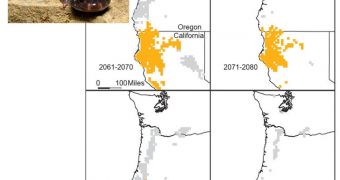Biologists at the Brown University recently conducted a simulation of how various species must evolve in order to adapt to the effects of global warming. Their results indicate that the ability to withstand more heat will be a critical factor separating those who survive from those who die.
However, the competition will not be a fair one. Before the Industrial Revolution began, centuries ago, lifeforms had thousands to millions of years to adapt to periods of climate change, with temperatures either rising or dropping. But now they will have to do so within a century or two.
This is a very short time span, Brown investigators say. They add that only species capable of adapting their bodies and metabolisms to increasing temperatures within the allotted time frame will endure to reproduce another day. This is why many of them will go extinct in the near future.
Details of the new investigation appear in the latest issue of the esteemed scientific journal Ecology Letters. Over the next century, temperatures around the globe are expected to increase by 2 degrees, if we're to consider the best possible scenario.
Previous studies have shown that many species can travel from their previous habitats to new ones, where climate conditions are similar to what they've gotten used to. But the Brown team says that the journey itself is perilous, since animals will have to endure temperature fluctuations along the way.
With the help of a computer model, Brown experts Reagan Early and Dov Sax managed to simulate the paths 15 amphibian species in the western United States will take throughout this century, up until 2100. Several climate change models were also factored into the simulation.
Results show that about half of the amphibian species will become endangered, or go extinct altogether, during their journeys. The severity and duration of temperature swings was found to play a critical role in their chance of survival.
“Our work shows that it’s not just how fast you disperse, but also your ability to tolerate unfavorable climate for decadal periods that will limit the ability of many species to shift their ranges,” Sax says.
“As a consequence, many species that aren’t currently of conservation concern are likely to become endangered by the end of the century,” adds the expert, who holds an appointment as an assistant professor of biology in the Department of Ecology and Evolutionary Biology at Brown.
As they adapt to new temperatures, “species can take two steps forward, but may be forced to take one step backward, because the climate may become unsuitable for them. Unfortunately, if they take a step back, they have to make up all of that ground,” Early, the lead author of the study, adds.
The new investigation was funded by the Portuguese Foundation of Science and Technology, the US Forest Service (USFS) and the Brown University.

 14 DAY TRIAL //
14 DAY TRIAL //